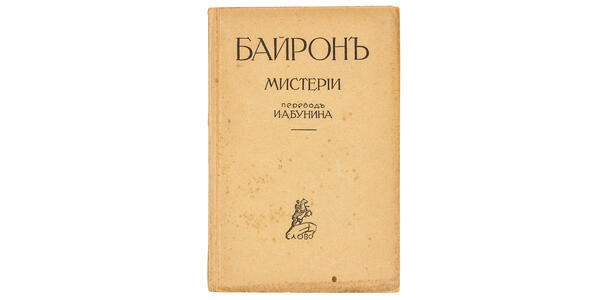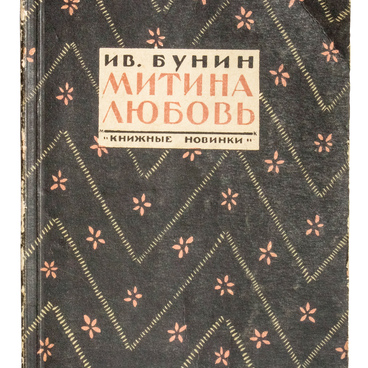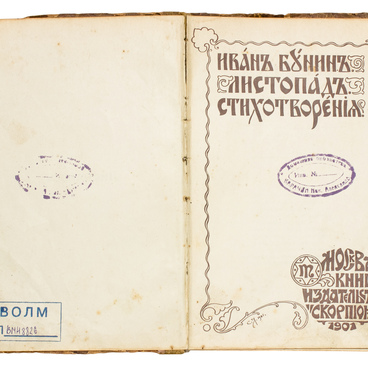In the 1920s, the publishing activities of ‘Russian Berlin’ reached its highest level. About sixty Russian newspapers and magazines were published in the German capital. Major publishers such as ‘Mysl’ (‘Thought’), ‘Slovo"(‘Word’), ‘Vrach"(‘Doctor’), ‘Helikon’, ‘Literature’, ‘Scythians’, ‘Ogonki"(‘Lights’), ‘Russkoe Tvorchestro"(Russian Art), ‘Epokha’ (‘Epoch’) and others. Russian classics, prose and poetry written by émigré were printed here. Between 1919 and 1924 over two thousand books were published in Russian, they were sold not only in Germany, but also in other European countries and the US.
Byron’s “Mysteries” include three works: “Cain”, “Manfred”, “Heaven and Earth”. The drama “Cain”, written in 1821, is considered one of the writer’s greatest works. The author based it the biblical legend of Cain, who killed his brother Abel. Such themes were often used for theater plays in the Middle Ages, so Byron titled the poem ‘Mystery’ (Mysteries were the earliest plays on biblical themes in medieval Europe). However, the author changed the laws of the genre by rethinking the meaning of Cain’s deed: the murderer became a true romantic hero who challenged God himself.
The Russian translation of the “Mysteries” appeared one hundred years after the original, in 1921. It was published by the Berlin publishing house “Slovo”. The translation was made by Ivan Bunin. Critics called the translation “outstanding”, “positively exemplary”, “a valuable contribution to Russian literature” and “a wonderful gift to the Russian reader.” They noted that “the translator did more than a good translation: he embraced the spirit of the original”. In 1909, Bunin received his second Pushkin Prize for his translations of Byron’s works and for his poems of 1903-1907.
Bunin’s interest in the works of the English poet was not accidental. He sought to comprehend the laws of creation, to seek out the mystery of life, its dark and light sides. At the same time Bunin sought to create a literary text as close to the original as possible.
Bunin was not the only one who was fascinated with Byron: in the culture of the early 20th century, Byron was immensely important. At that time, works of the English Romantic poet were regularly translated into Russian, and his books were printed in large print runs. Characters created by Byron often appeared in theatrical productions and musical performances. Interest in the English writer was evident in Russian literary studies, philosophical and literary journalism.
Byron’s “Mysteries” include three works: “Cain”, “Manfred”, “Heaven and Earth”. The drama “Cain”, written in 1821, is considered one of the writer’s greatest works. The author based it the biblical legend of Cain, who killed his brother Abel. Such themes were often used for theater plays in the Middle Ages, so Byron titled the poem ‘Mystery’ (Mysteries were the earliest plays on biblical themes in medieval Europe). However, the author changed the laws of the genre by rethinking the meaning of Cain’s deed: the murderer became a true romantic hero who challenged God himself.
The Russian translation of the “Mysteries” appeared one hundred years after the original, in 1921. It was published by the Berlin publishing house “Slovo”. The translation was made by Ivan Bunin. Critics called the translation “outstanding”, “positively exemplary”, “a valuable contribution to Russian literature” and “a wonderful gift to the Russian reader.” They noted that “the translator did more than a good translation: he embraced the spirit of the original”. In 1909, Bunin received his second Pushkin Prize for his translations of Byron’s works and for his poems of 1903-1907.
Bunin’s interest in the works of the English poet was not accidental. He sought to comprehend the laws of creation, to seek out the mystery of life, its dark and light sides. At the same time Bunin sought to create a literary text as close to the original as possible.
Bunin was not the only one who was fascinated with Byron: in the culture of the early 20th century, Byron was immensely important. At that time, works of the English Romantic poet were regularly translated into Russian, and his books were printed in large print runs. Characters created by Byron often appeared in theatrical productions and musical performances. Interest in the English writer was evident in Russian literary studies, philosophical and literary journalism.



